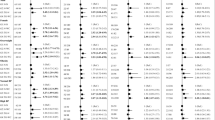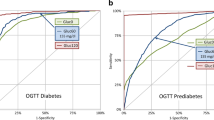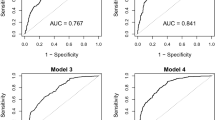Abstract
Objectives:
The objective of this study was to define metabolic normality and to investigate the cardiometabolic profile of metabolically normal obese.
Design:
Cross-sectional study conducted at 21 research centers in Europe.
Subjects:
Normal body weight (nbw, n=382) and overweight or obese (ow/ob, n=185) subjects free from metabolic syndrome and with normal glucose tolerance, were selected among the Relationship between Insulin Sensitivity and Cardiovascular Disease study participants.
Main outcome measures:
Insulin sensitivity was assessed by the clamp technique. On the basis of quartiles in nbw subjects, the limits of normal insulin sensitivity and of normal fasting insulinemia were established. Subjects with normal insulin sensitivity and fasting insulin were defined as metabolically normal.
Results:
Among ow/ob subjects, 11% were metabolically normal vs 37% among nbw, P<0.0001. Ow/ob subjects showed increased fasting insulin (P=0.0009), low-density lipoprotein cholesterol (LDL-cholesterol) (P=0.004), systolic (P=0.0007) and diastolic (P=0.001) blood pressure, as compared with nbw. When evaluating the contribution of body mass index (BMI), hyperinsulinemia and insulin resistance, BMI showed an isolated effect on high-density lipoprotein (P=0.007), high-sensitivity C-reactive protein (P<0.0001), systolic (P=0.002) and diastolic (P=0.008) blood pressures. BMI shared its influence with insulinemia on total cholesterol (P=0.04 and 0.003, respectively), LDL-cholesterol (P=0.003 and 0.006, respectively) and triglycerides (P=0.02 and 0.001, respectively).
Conclusion:
In obese subjects, fasting insulin should be taken into account in the definition of metabolic normality. Even when metabolically normal, obese subjects could be at increased risk for cardiometabolic diseases. Increased BMI, alone or with fasting insulin, is the major responsible for the less favorable cardio-metabolic profile.
This is a preview of subscription content, access via your institution
Access options
Subscribe to this journal
Receive 12 print issues and online access
$259.00 per year
only $21.58 per issue
Buy this article
- Purchase on Springer Link
- Instant access to full article PDF
Prices may be subject to local taxes which are calculated during checkout


Similar content being viewed by others
References
Hubert HB, Feinleib M, McNamara PM, Castelli WP . Obesity as an independent risk factor for cardiovascular disease: a 26-year follow-up of participants in the Framingham Heart Study. Circulation 1983; 67: 968–977.
Mokdad AH, Bowman BA, Ford ES, Vinicor F, Marks JS, Koplan JP . The continuing epidemics of obesity and diabetes in the United States. JAMA 2001; 286: 1195–1200.
Wildman RP, Muntner P, Reynolds K, McGinn AP, Rajpathak S, Wylie-Rosett J et al. The obese without cardiometabolic risk factor clustering and the normal weight with cardiometabolic risk factor clustering: prevalence and correlates of 2 phenotypes among the US population (NHANES 1999-2004). Arch Intern Med 2008; 168: 1617–1624.
Stefan N, Kantartzis K, Machann J, Schick F, Thamer C, Rittig K et al. Identification and characterization of metabolically benign obesity in humans. Arch Intern Med 2008; 168: 1609–1616.
Brochu M, Tchernof A, Dionne IJ, Sites CK, Eltabbakh GH, Sims EA et al. What are the physical characteristics associated with a normal metabolic profile despite a high level of obesity in postmenopausal women? J Clin Endocrinol Metab 2001; 86: 1020–1025.
Kelishadi R, Cook SR, Motlagh ME, Gouya MM, Ardalan G, Motaghian M et al. Metabolically obese normal weight and phenotypically obese metabolically normal youths: the CASPIAN Study. J Am Diet Assoc 2008; 108: 82–90.
Grundy SM, Brewer Jr HB, Cleeman JI, Smith Jr SC, Lenfant C . Definition of metabolic syndrome: report of the National Heart, Lung, and Blood Institute/American Heart Association conference on scientific issues related to definition. Circulation 2004; 109: 433–438.
Matthews DR, Hosker JP, Rudenski AS, Naylor BA, Treacher DF, Turner RC . Homeostasis model assessment: insulin resistance and beta-cell function from fasting plasma glucose and insulin concentrations in man. Diabetologia 1985; 28: 412–419.
DeFronzo RA, Tobin JD, Andres R . Glucose clamp technique: a method for quantifying insulin secretion and resistance. Am J Physiol 1979; 237: E214–E223.
Ferrannini E, Haffner SM, Mitchell BD, Stern MP . Hyperinsulinaemia: the key feature of a cardiovascular and metabolic syndrome. Diabetologia 1991; 34: 416–422.
Bonora E, Capaldo B, Perin PC, Del Prato S, De Mattia G, Frittitta L et al. Hyperinsulinemia and insulin resistance are independently associated with plasma lipids, uric acid and blood pressure in non-diabetic subjects. The GISIR database. Nutr Metab Cardiovasc Dis 2008; 18: 624–631.
de Rooij S, Dekker J, Kozakova M, Mitrakou A, Melander O, Gabriel R et al. Fasting insulin has a stronger association with an adverse cardio-metabolic risk profile than insulin resistance: the RISC study. Eur J Endocrinol 2009; 161: 223–230.
Alberti KG, Zimmet P, Shaw J . Metabolic syndrome--a new world-wide definition. A consensus statement from the International Diabetes Federation. Diabet Med 2006; 23: 469–480.
O'Leary DH, Polak JF, Kronmal RA, Manolio TA, Burke GL, Wolfson Jr SK . Carotid-artery intima and media thickness as a risk factor for myocardial infarction and stroke in older adults. Cardiovascular Health Study Collaborative Research Group. N Engl J Med 1999; 340: 14–22.
Hills SA, Balkau B, Coppack SW, Dekker JM, Mari A, Natali A et al. The EGIR-RISC STUDY (The European group for the study of insulin resistance: relationship between insulin sensitivity and cardiovascular disease risk): I methodology and objectives. Diabetologia 2004; 47: 566–570.
Ferrannini E, Balkau B, Coppack SW, Dekker JM, Mari A, Nolan J et al. Insulin resistance, insulin response, and obesity as indicators of metabolic risk. J Clin Endocrinol Metab 2007; 92: 2885–2892.
Mercuri M, McPherson DD, Bassiouni H, Glagov S . Non-invasive imaging of atherosclerosis. Kluwer, The Netherlands, 1998.
Mazzone AM, Urbani MP, Picano E, Paterni M, Borgatti E, De Fabritiis A et al. In vivo ultrasonic parametric imaging of carotid atherosclerotic plaque by videodensitometric technique. Angiology 1995; 46: 663–672.
Ekelund U, Griffin SJ, Wareham NJ . Physical activity and metabolic risk in individuals with a family history of type 2 diabetes. Diabetes Care 2007; 30: 337–342.
Freedson PS, Melanson E, Sirard J . Calibration of the Computer Science and Applications, Inc. accelerometer. Med Sci Sports Exerc 1998; 30: 777–781.
Masse LC, Fuemmeler BF, Anderson CB, Matthews CE, Trost SG, Catellier DJ et al. Accelerometer data reduction: a comparison of four reduction algorithms on select outcome variables. Med Sci Sports Exerc 2005; 37: S544–S554.
Olufadi R, Byrne CD . Clinical and laboratory diagnosis of the metabolic syndrome. J Clin Pathol 2008; 61: 697–706.
Kuk JL, Ardern CI . Are metabolically normal but obese individuals at lower risk for all-cause mortality? Diabetes Care 2009; 32: 2297–2299.
Iacobellis G, Ribaudo MC, Zappaterreno A, Iannucci CV, Leonetti F . Prevalence of uncomplicated obesity in an Italian obese population. Obes Res 2005; 13: 1116–1122.
Katzmarzyk PT, Janssen I, Ross R, Church TS, Blair SN . The importance of waist circumference in the definition of metabolic syndrome: prospective analyses of mortality in men. Diabetes Care 2006; 29: 404–409.
Buchowski MS, Acra S, Majchrzak KM, Sun M, Chen KY . Patterns of physical activity in free-living adults in the southern United States. Eur J Clin Nutr 2004; 58: 828–837.
Balkau B, Mhamdi L, Oppert JM, Nolan J, Golay A, Porcellati F et al. Physical activity and insulin sensitivity: the RISC study. Diabetes 2008; 57: 2613–2618.
Messier V, Karelis AD, Prud'homme D, Primeau V, Brochu M, Rabasa-Lhoret R . Identifying metabolically healthy but obese individuals in sedentary postmenopausal women. Obesity (Silver Spring) 2010; 18: 911–917.
Acknowledgements
The RISC study was supported by the EU grant no. QLG1-CT-2001-01252 and by an additional grant from AstraZeneca (Sweden). Locally, the Geneva center received the support of the Whilsdorf Foundation and of the Swiss Life Insurance Foundation.
Author information
Authors and Affiliations
Consortia
Corresponding author
Ethics declarations
Competing interests
The authors declare no conflict of interest.
Additional information
RISC investigators
RISC recruiting centers: Amsterdam, The Netherlands: RJ Heine, J Dekker, G Nijpels, W Boorsma; Athens, Greece: A Mitrakou, S Tournis, K Kyriakopoulou, P Thomakos; Belgrade, Serbia and Montenegro: N Lalic, K Lalic, A Jotic, L Lukic, M Civcic; Dublin, Ireland: J Nolan, TP Yeow, M Murphy, C DeLong, G Neary, MP Colgan, M Hatunic; Frankfurt, Germany: T Konrad, H Böhles, S Fuellert, F Baer, H Zuchhold; Geneva, Switzerland: A Golay, E Harsch Bobbioni, V Barthassat, V Makoundou, TNO Lehmann, T Merminod; Glasgow, Scotland: JR Petrie (now Dundee), C Perry, F Neary, C MacDougall, K Shields, L Malcolm; Kuopio, Finland: M Laakso, U Salmenniemi, A Aura, R Raisanen, U Ruotsalainen, T Sistonen, M Laitinen, H Saloranta; London, UK: SW Coppack, N McIntosh, P Khadobaksh; Lyon, France: M Laville, F Bonnet, A Brac de la Perriere, C Louche-Pelissier, C Maitrepierre, J Peyrat, A Serusclat; Madrid, Spain: R Gabriel, EM Sánchez, R Carraro, A Friera, B Novella; Malmö, Sweden (1): P Nilsson, M Persson, G Östling; (2): O Melander, P Burri; Milan, Italy: PM Piatti, LD Monti, E Setola, E Galluccio, F Minicucci, A Colleluori; Newcastle-upon-Tyne, UK: M Walker, IM Ibrahim, M Jayapaul, D Carman, K Short, Y McGrady, D Richardson; Odense, Denmark: H Beck-Nielsen, P Staehr, K Hojlund, V Vestergaard, C Olsen, L Hansen; Perugia, Italy: GB Bolli, F Porcellati, C Fanelli, P Lucidi, F Calcinaro, A Saturni; Pisa, Italy: E Ferrannini, A Natali, E Muscelli, S Pinnola, M Kozakova; Rome, Italy: G Mingrone, C Guidone, A Favuzzi, P Di Rocco; Vienna, Austria: C Anderwald, M Bischof, M Promintzer, M Krebs, M Mandl, A Hofer, A Luger, W Waldhäusl, M Roden.
Project management board: B Balkau (Villejuif, France), SW Coppack (London, UK), JM Dekker (Amsterdam, The Netherlands), E Ferrannini (Pisa, Italy), A Mari (Padova, Italy), A Natali (Pisa, Italy) and M Walker (Newcastle, UK).
Core laboratories and reading centers: lipids, Dublin, Ireland: P Gaffney, J Nolan, G Boran; hormones, Odense, Denmark: C Olsen, L Hansen, H Beck-Nielsen; albumin/creatinine, Amsterdam, The Netherlands: A Kok, J Dekker; genetics, Newcastle-upon-Tyne, UK: S Patel, M Walker; stable isotope laboratory, Pisa, Italy: A Gastaldelli, D Ciociaro.
Ultrasound reading center: Pisa, Italy: M Kozakova; ECG reading, Villejuif, France: MT Guillanneuf; data management, Villejuif, France: B Balkau, L Mhamdi; mathematical modeling and website management, Padova, Italy: A Mari, G Pacini, C Cavaggion; coordinating office, Pisa, Italy: SA Hills, L Landucci, L Mota.
Further information on the RISC Study and participating centers can be found at http://www.egir.org.
All the co-authors had full access to all data in the study and take responsibility for the integrity of the data and the accuracy of the data analysis.
Rights and permissions
About this article
Cite this article
Pataky, Z., Makoundou, V., Nilsson, P. et al. Metabolic normality in overweight and obese subjects. Which parameters? Which risks?. Int J Obes 35, 1208–1215 (2011). https://doi.org/10.1038/ijo.2010.264
Received:
Revised:
Accepted:
Published:
Issue Date:
DOI: https://doi.org/10.1038/ijo.2010.264
Keywords
This article is cited by
-
Predictors of the transition from metabolically healthy obesity to unhealthy obesity
Eating and Weight Disorders - Studies on Anorexia, Bulimia and Obesity (2018)
-
Prevalence of different metabolic phenotypes of obesity in Iranian children and adolescents: the CASPIAN V study
Journal of Diabetes & Metabolic Disorders (2018)
-
De la dysfonction du tissu adipeux blanc aux phénotypes anatomocliniques de l’obésité
Obésité (2017)
-
Natural course of metabolically healthy abdominal obese adults after 10 years of follow-up: the Tehran Lipid and Glucose Study
International Journal of Obesity (2015)
-
Morbidly “Healthy” Obese Are Not Metabolically Healthy but Less Metabolically Imbalanced Than Those with Type 2 Diabetes or Dyslipidemia
Obesity Surgery (2015)



